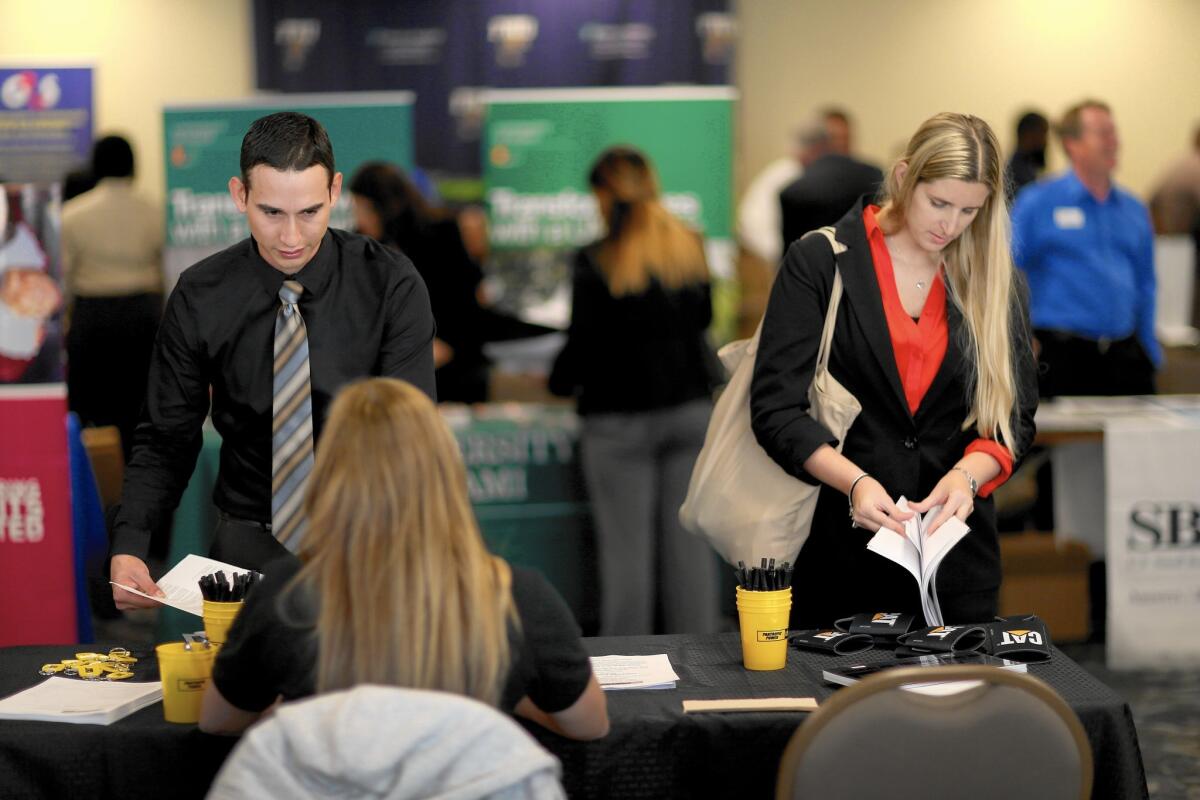Strong U.S. jobs report shows best wage growth in six years

- Share via
Reporting from washington — With strong employment gains in January, the economy has created more than 1 million new jobs in a three-month stretch for the first time in nearly two decades — and the hiring surge has spurred the best wage gains in more than six years.
The 257,000 net new jobs that employers added last month were spread across high- and low-paying industries, the Labor Department said Friday in a report that economists described as overwhelmingly positive.
The upbeat data increased the likelihood that the Federal Reserve would start raising interest rates as early as June, beginning a slow pullback on its remaining effort to stimulate the economy and put the Great Recession far behind it.
Even the biggest negative in the report, a tick up in the unemployment rate to 5.7%, was a plus. Economists said it happened because 703,000 more people jumped into the civilian labor force last month.
“The labor market is gaining momentum,” said Sophia Koropeckyj, senior economist at Moody’s Analytics. “Employers have strong enough demand for their products and services that they really have to start ramping up their hiring.”
During a town hall forum in Indianapolis, President Obama touted the gain in jobs and broader signs of an improving economy.
“And in the single most hopeful sign for middle-class families, wages are starting to go up again,” Obama said. “So America is poised for another good year.”
Average private hourly earnings rose 12 cents to $24.75 in January after a disappointing drop of 5 cents the previous month. The 0.5% gain in January was the best since late 2008 as the Great Recession was nearing its depths.
“We have been expecting both stronger wage growth and stronger labor force growth,” said Gus Faucher, senior economist at PNC Financial Services Group. “Certainly this is a good start, but let’s see if it continues.”
The report showed that the private sector is driving the economy. It added 267,000 new jobs last month while governments cut back by 10,000 positions, the worst performance in a year.
Federal, state and local governments have struggled to add workers after the recession amid budget deficits, stunted tax revenue growth and, until recently, a sluggish economy. While private employers added 3.1 million new jobs over the previous 12 months, the best since 1998, government employment rose just 80,000 in that time.
Lower-paying private jobs had the biggest increase last month, with retailers adding about 46,000 positions and hotels and restaurants combining for 37,000 new jobs. But good-paying industries such as construction, manufacturing and business services also showed strong gains.
In addition, the Labor Department revised the number of new jobs for the previous two months, saying the economy added 147,000 more positions than initially estimated for November and December combined.
November’s 423,000 figure was the best since the spring of 2010, when temporary federal government hiring to conduct the census gave the jobs market a one-month boost.
The revisions meant that total job creation nudged over 1 million for the previous three months, a total the economy hadn’t produced in a three-month period since 1997. The average job gains of 336,000 from November through January were an acceleration in hiring from last year’s pace of 260,000 a month.
The economic recovery has been plagued by slowly rising paychecks for typical workers even as corporate profits have soared.
Average hourly earnings were up 2.2% for the 12 months that ended Jan. 31. The consumer price index rose just 0.7% last year, largely because of falling oil prices. The gap shows that wage growth easily outpaced inflation.
Still, overall wage growth has hovered around 2% since the recession ended in mid-2009. Average hourly earnings were rising more than 3% annually before the downturn.
Doug Handler, chief U.S. economist at IHS Global Insight, said it’s too early to say the economy has turned the corner on wage growth. But as the number of unemployed workers shrinks, pressure will increase on employers to boost salaries. He estimated that wage growth should reach about 2.5% this year.
“We’re slowly inching our way up,” Handler said.
Earnings got a bump last month because the minimum wage rose in 20 states, though many of those increases were relatively small, cost-of-living adjustments.
An increase in the federal minimum wage, which hasn’t risen since 2009 and has not kept up with inflation for decades, would help boost earnings for average workers, said Damon Silvers, policy director of the AFL-CIO.
“It’s good to see a little bit of wage growth in the economy,” he said of the jobs report. “Unfortunately, in this recovery, even as job growth has accelerated, wage growth has been the exception rather than the rule.”
Fed officials are watching wage growth closely as a final indicator that the labor market is healthy enough to start raising rock-bottom, short-term interest rates.
“The quite modest growth of wages across the economy does not seem normal given the solid growth numbers we’ve seen in recent quarters,” Dennis Lockhart, president of the Federal Reserve Bank of Atlanta, said in a speech to a Florida business group Friday.
Still, he said, improving labor market conditions meant that the Fed could start raising its benchmark rate as early as June.
More to Read
Inside the business of entertainment
The Wide Shot brings you news, analysis and insights on everything from streaming wars to production — and what it all means for the future.
You may occasionally receive promotional content from the Los Angeles Times.











